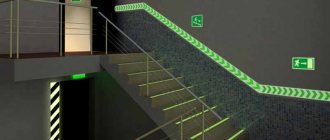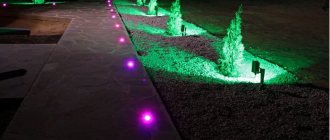Emergency lighting
The presence of artificial lighting at large production facilities and in crowded places is necessary to save people's lives. Therefore, in situations where the power system fails (accident, fire), the emergency lighting system (ELS) is activated.
SAO is not a backup lighting that is activated in the absence of the main one. This is a separate independent system that functions when the main and backup power sources fail.
The power source for emergency lighting lamps is independent autonomous equipment (a generator station or battery that receives “recharging” energy from the main power supply circuit). The entire system operates automatically using an electronic unit or control panel, which transmits a signal to supply voltage to the automatic control system in the event of a malfunction of the main circuit.
The task of the system is to safely evacuate people/personnel to the exit, and also, in case of production necessity, to create conditions for the continuation or completion of the work process.
Part of the emergency lighting system (ELS)
Contents
Normative base
The proper functioning of the emergency control system is vital for people in emergency situations. Therefore, every step, from the design stage to installation work, is regulated by a set of rules and standards, which are described in more detail below.
Basic requirements and standards
The list of main regulatory documents is presented in the table:
| Title of the document | Brief description/link to current resource |
| PUE-7 dated 01/01/2003 | Rules for electrical installations. Edition 7. The book describes the basic rules for the design, installation and operation of electrical installations. https://en-res.ru/wp-content/uploads/2020/02/pue.pdf |
| SP 52.13330.2016 dated 05/08/2017 Updated version of SNiP 23-25-95 | A set of rules regulating the regulatory values of artificial and natural lighting of buildings, structures, and production sites. https://docs.cntd.ru/document/456054197 |
| Federal Law of the Russian Federation No. 123 dated July 22, 2008. (last edition dated December 27, 2018) | Federal Law of the Russian Federation “Technical Regulations on Fire Safety Requirements”. https://www.consultant.ru/document/cons_doc_LAW_78699 |
| GOST R 55842-2013 dated 01/01/2015 | National standard of the Russian Federation. Emergency lighting. Classification and norms. https://docs.cntd.ru/document/1200107497 |
| Federal Law of the Russian Federation No. 384 dated December 30, 2009. (last edition dated 07/02/2013) | Federal Law of the Russian Federation “Technical Regulations on the Safety of Buildings and Structures” https://www.consultant.ru/document/cons_doc_LAW_95720 |
| SP 31-110-2003 | Set of rules. Set of rules for design and construction. Design and installation of electrical installations of residential and public buildings. https://docs.cntd.ru/document/1200035252 |
| SP 3.13130.2009 | Set of rules. Fire protection systems. Warning and management system for evacuation of people in case of fire. Fire safety requirements. https://docs.cntd.ru/document/1200071145 |
| SP 6.13130.2013 | Set of rules. Fire protection systems. Electrical equipment. Fire safety requirements. https://docs.cntd.ru/document/1200100259 |
| SP 52.13330.2016 | Set of rules. Natural and artificial lighting. https://docs.cntd.ru/document/456054197 |
| GOST R 50571.29-2009 (IEC 60364-5-55:2008) | National standard of the Russian Federation. Electrical installations of buildings. Part 5-55. Selection and installation of electrical equipment. Other equipment. https://docs.cntd.ru/document/1200072903 |
| GOST 1ES 60598-2-22-2012 | National standard of the Russian Federation. Lamps. Private requirements. Lamps for emergency lighting. https://docs.cntd.ru/document/1200097788 |
| GOST R 50571.5.56-2013 IEC 60364-5-56:2009 | National standard of the Russian Federation Low-voltage electrical installations. Part 5-56. Selection and installation of electrical equipment. Security systems." Date of introduction: 01/01/2015. https://docs.cntd.ru/document/1200105243 |
| GOST R 51514-2013 (IEC:61547:2009) | National standard of the Russian Federation. Electromagnetic compatibility of technical equipment. Resistance of general-purpose lighting equipment to electromagnetic interference. Requirements and test methods. Date of introduction – 01/01/2014. https://docs.cntd.ru/document/1200104773 |
| GOST 12.4.026-2015 | Interstate standard. System of occupational safety standards. Signal colors, safety signs and signal markings. Purpose and rules of use. General technical requirements and characteristics. Test methods. Date of introduction – 03/01/2017. https://docs.cntd.ru/document/1200136061 |
| TR TS 004/2011 | Technical regulations of the customs union. On the safety of low-voltage equipment. Date of introduction – 08/16/2011. https://docs.cntd.ru/document/902299536 |
Basic requirements for the selection and installation of emergency lighting systems:
- power is supplied from an autonomous independent power source (Federal Law No. 384, Article 2, Part 2.1; SP 52.13330.2016 clause 7.6.1);
- turning on the self-propelled gun - automatically or manually (Federal Law No. 384, Art. 2, Part 2.1; SP 52.13330.2016, Clause 7.6.1);
- voltage is supplied to the emergency network in such a way that 5 seconds after the working lighting is turned off, the normalized illumination value of the object is more than 50%, after 10 seconds - 100% (SP 52.13330.2016 clause 7.6.7, table 7.28);
- operating time - less than 1 hour (SP 52.13330.2016 clause 7.6.10);
- EAS must be configured to work in conjunction with fire safety devices (illumination of signs and panels) (Federal Law No. 384, Art. 2, Part 2.1).
Emergency lighting requirements
Requirements for installation and selection of lamps should be made in accordance with the following requirements:
- the norm of illumination indoors is at least 0.5 lux, in open areas - at least 0.2 lux (SP 52.13330.2016 clause 7.6.7, table 7.28);
- the unevenness of the light flux along the trajectory of movement (escape route) is 40/1 (the ratio of the illumination value at the most illuminated point to its lowest value) (SP 52.13330.2016 clause 7.6.2).
Requirements for installing evacuation signs:
- are established in the following cases (SP 52.13330.2016 clause 7.6.9):
- production premises with an area of more than 150 sq.m;
- presence of more than 100 people in the building;
- a room without natural light, in which there are more than 50 people;
- signs may have their own lighting system from an autonomous power source, or they may be illuminated by emergency lighting fixtures (SP 52.13330.2016 clause 7.6.10);
- Continuous lighting of indicators from working lighting is allowed;
- the distance between signs is at least 25 meters;
- in places of turns, entrances/exits, and junctions of other rooms, additional evacuation signs are installed (SP 52.13330.2016 clause 7.6.9);
- the overall dimensions of the signs must ensure their 100% visibility (SP 52.13330.2016 clause 7.6.10).
The rules for the design of electrical installations (Chapter 6.1 PUE-7) prescribe the classification of emergency lighting, categories of lamps, signs, their power sources and connection diagrams to the power supply network.
What it is
Emergency lighting is a lighting system that has the ability to operate autonomously, while this type of lighting is connected to the lighting installation. This view creates a certain type of visibility that allows people to navigate the space in cases of shutdown or malfunction of the central lighting. This system creates lighting that allows people to easily navigate industrial, industrial premises and residential buildings. The installed system must comply with the rules for installing electrical appliances.
Production
Important! The system is an integral part of the central lighting of buildings and structures in regions most often prone to natural disasters. Thus, this type of lighting should be installed at all production facilities.
Categories of emergency lighting consumers
According to the categories established by the rules (PUE-7 clause 1.2.18), the following are distinguished:
First category. Objects of special strategic importance. The personnel located at this facility are directly involved in maintaining state security. In this case, emergency lighting should be lined up at the level of the main one.
Second category. Objects whose downtime leads to massive disruptions in production technology, defects and, as a consequence, losses. They also have a negative impact on businesses that interact with them. CAO is similar to the first category.
Third category. At such facilities, a lack of electrical energy is allowed for up to 24 hours. Emergency lighting is started from autonomous power sources (diesel generator, batteries) to ensure uninterrupted evacuation of personnel.
Parts List
For this emergency lighting circuit you will need the following parts:
- R1 = 1M, ¼ Watt, 5%, CFR
- R2 = 10K, ¼ Watt, 5%, CFR
- R3 = 10 Ohm 1 W
- ALL LED resistors = 22 Ohm, W
- C1 = 205/400 V, gearbox
- C2 = 100 µF, 25 V
- Z1 = 9 V, 1 W
- T1 = BD 140
- ALL DIODES = 1N4007
- S1 = 3-way switch
- BATTERY = 6 Volt 4 Ah
- LED = WHITE, 5mm.
Connect a bank of white LEDs with a few series resistors to a 12-volt battery and your LED emergency lighting circuit is complete!
The current LED emergency lighting scheme is different from others in that it consumes very little battery power (6 Volts) and thus remains illuminated for at least 40% longer than its conventional counterparts.
It is also interesting that it is voltage, not current, that is important to keep white LEDs glowing . This property of white LEDs has been exploited here.
Emergency lighting classification
Emergency lighting is classified (SP 52.13330.2016 clause 7.6.1) according to the following scheme
Emergency lighting classification
Reserve
Emergency backup lighting (SP 52.13330.2016 clause 7.6.6) is clearly highlighted as a separate branch and has a different function from evacuation lighting. This is the replacement of the main (working) lighting when the latter fails or during its planned shutdown (for example, periodic repair work).
The duration of operation of the backup line is not limited, i.e. it operates until the main line is restored to working order. Therefore, the technical and operational characteristics of the reserve are aligned with those of the workers.
The working and backup lines are powered by two independent power sources, and the rest of the “lighting circuit” is common. The principle of operation of such a scheme is simple: when the main line is extinguished, a backup source is automatically switched on, which supplies voltage to the same lamps as the main one. Implementing backup lighting on individual lighting sources is neither practical nor profitable.
However, its presence does not exclude the installation of evacuation lighting devices.
The presence of backup lighting is necessary in places of continuous production - factories, train stations, airports, hospitals. However, it is mandatory for kindergartens and schools and does not depend on the number of people in the building.
Evacuation
Emergency evacuation lighting consists of lighting high-risk areas and evacuation routes, taking into account the system for indicating them.
Lighting of high-risk areas (SP 52.13330.2016 clause 7.6.5) protects personnel from dangers when working at height and with specialized vehicles (area of loading and unloading mechanisms, unfenced areas) and technological processes (factory machines, tanks with chemical liquids, exposed conductive parts).
In the event that it is impossible to stop the production process in the specified zone, lighting is implemented in the same circuit as the backup one.
Lighting of high-risk areas (continuous production)
The task of lighting evacuation routes (SP 52.13330.2016 clause 7.6.3) is the safe evacuation of people. Evacuation route devices are located along the entire route, from the first exit from the place of work/residence to the exit from the building.
Lamps and signs are backlit with schematic, readable information signs (directional arrow, pharmacy cross, fire hydrant).
Evacuation route lighting
Anti-panic
The task of anti-panic lighting (SP 52.13330.2016 clause 7.6.4) is to minimize the state of panic among people in the event of an accident and ensure the visibility of evacuation signs from any point.
The readability of information signs and guaranteed illumination help direct people’s actions to the evacuation site without the onset of panic.
It must be installed in indoor and outdoor areas with an area of more than 60 sq.m., as well as when the evacuation plan from the site is difficult.
Operating conditions of anti-panic lighting
Design standards
The light levels on the surface when starting security lighting should be at least 10 lux for incandescent lamps, and for fluorescent lamps this figure should be at least 15 lux.
Evacuation light indicators in narrow corridors and small rooms must be at least 0.5 lux. In large and bright rooms this figure can be from 0.2 lux.
Design
In large rooms, escape routes must be equipped with indicating arrows located in the direction of the emergency exit. Signs must be placed at least every 25 meters and at every turn. The installation location may be the walls or even the ceiling of the room, but within the visibility of the evacuated personnel. Instead of arrows, it is allowed to install decorative lighting fixtures with an arrow stencil made in accordance with the standards. These rules and regulations apply to the following objects:
- The area of the production workshop exceeds 150 m2;
- there is a room with 100 people or more at the same time;
- objects where there is no natural light source and there are 50-100 personnel at the same time.
You might be interested in this: The difference between white and yellow light
Emergency lighting must be connected to a backup network and not depend on the main electrical network. Evacuation lighting and safety lighting should be independent, but at the same time they should complement each other. For this purpose they are connected to their own power supply.
Emergency devices can function continuously, complementing the central lighting, and can also be connected (in manual or automatic modes) in the event of an emergency.
When devices automatically switch to backup power, it is necessary to consider the possibility of returning to the main power source when the central network is restored.
If it is impossible to use an automatic transfer, it is necessary to install a special panel equipped with mechanical switches, allowing the personnel on duty to manually turn off the backup power and connect to the main electrical network, in accordance with the operating instructions and observing safety requirements.
Lamps equipped with batteries have separate requirements. Due to their low power, they are used for installation in evacuation lamps and are turned on in rare cases. To ensure that the battery does not self-discharge and does not provide power to the lamp at the right time, these devices are equipped with a remote control. With its help, the equipment is checked for serviceability and, if necessary, the battery can be charged in the future.
Important! It is prohibited to connect more than 20 light sources to one emergency power supply network. The total power of this equipment should not be more than 60% of the ability to protect the emergency power grid.
Luminaires must be installed in such a way as to provide uniform light for escape routes. To avoid disorientation of personnel during evacuation, it is necessary to avoid sudden changes when installing lighting fixtures.
Lamp
Lamps indicating directions during evacuation must have designs with clear boundaries that are understandable to people.
Additional Information! The colors applied to the lamp should not develop panic feelings and should not have an aggressive palette. The most suitable color is green.
Light sign
Equipment designed to start and turn off emergency lighting must be mounted in a special place that is accessible to maintenance personnel and at the same time inaccessible to unauthorized entry by other persons not involved in the process. Devices must be protected by fireproof cabinets with mandatory marking of all elements.
It is prohibited to install an emergency power supply network in parallel with the main network. In this case, if a malfunction occurs in the main network, there is a high possibility of problems occurring on the backup network. The latter must have an individual gasket and have independent equipment. In addition, all installations must be equipped with fire partitions.
When installing the emergency lighting system and its components, it is necessary to avoid areas where there is a high risk of any emergency. Launch equipment must be placed in premises that are the safest and have easy access in the event of an emergency.
Emergency light
It is necessary to periodically check the equipment by starting and switching it. Special equipment in the form of test programs is used for inspections (mandatory for the first category). Drill evacuation is carried out at facilities belonging to the second and third categories (it is necessary to obtain approval from the relevant security authorities).
Requirements
Types of lamps
Based on the type of power supply, luminaires are divided into those equipped with an emergency power supply unit (EPU) and without it (GOST 1EC 60598-2-22-2012 clause 22.3.8).
Lamps without BAP are ordinary, familiar to everyone, lighting devices (LDs), which receive backup power from an electrical energy generator and/or battery installation.
Emergency battery emergency lighting lamps with built-in BAP according to operating mode :
- continuous (permanent) action (GOST 1ES 60598-2-22-2012 clause 22.3.5). They continuously receive power from one of 2 sources: the main emergency power supply system or the UPS directly. When the main system is turned off, the lamp is automatically connected to the emergency power supply.
The advantage of this mode of operation is the ease of installation of the circuit and selection of the OP; they do not require special connection skills and can be used at any site.
Constant-on emergency lamps are implemented using conventional artificial lighting fixtures, most often LED emergency lamps, and do not require additional design and installation work. To recognize them, a marking is applied to the OP body - the red letter “A”.
The downside is the high cost.
An example of a continuous (permanent) emergency lamp
DPA-2101
- Emergency (periodic) switching on (GOST 1EC 60598-2-22-2012 clause 22.3.6). A data cable is laid from the distribution board to the OP group, through which a signal is transmitted in the absence of voltage in the main network. The lighting device automatically connects to the UPS and lights up.
The advantage of this mode is its low cost, relative to OP with BAP. Possibility of using inexpensive, low-resource (their operating time is from 1 to 3 hours) components.
Example of an intermittent emergency luminaire KL-60
- Combined (GOST 1ES 60598-2-22-2012 clause 22.3.7). Structurally, they are made of 2 or more lamps, each of which is configured for a specific mode (continuous or emergency).
The operating principle of such a lamp is similar to the power supply circuit of an SAO with two independent light sources. For example, in normal mode: when powered from the main network, lamp No. 1 is on, lamp No. 2 is off. In emergency mode: the voltage in the main network disappears and lamps No. 1, 2 automatically switch to the BAP, while lamp No. 1 continues to light, and lamp No. 2 lights up.
Example of a combined emergency luminaire ONTEC S M1
The design of autonomous emergency lighting lamps directly depends on their functional purpose (operating mode):
- Lamps with surface-mounted shades, linear, modular and raster, are used in backup (evacuation) lamps of continuous (permanent) operation.
Raster lamp
- Spot lamps and lampshades are installed in evacuation lamps of continuous (permanent) or periodic (emergency) operation.
Spotlight
- Rectangular or disc-shaped lampshades with a pictogram printed inside are used in continuous and periodic light indicators.
Example of light indicator (exit)
According to the rules (SP 52.13330.2016 clause 7.6.2), the following light sources can be used to implement self-regulatory systems:
- LED lamp. High luminous efficiency, which allows the use of batteries in BAPs of smaller capacity. The use of an emergency LED lamp is more profitable than incandescent lamps.
- Fluorescent Lamp. Application conditions: the value of the supply voltage (in any mode) is more than 90% of its nominal value, and the air temperature at the installation site is more than 5°C. Most often they are used for backup lighting of objects where the main lighting is provided using gas-discharge lamps.
- High pressure discharge lamp. Application conditions: minimum time to restart the lamp (lights up instantly) regardless of the state (cold or hot). Those. even after it is turned off, it does not require time to cool down before turning on again.
- Incandescent lamp – if the use of other light sources is prohibited.
Switching method
Emergency lighting is turned on when the main one is turned off. In this case, a special relay reacts to a power failure, which turns on the emergency lighting system. This switch must be selected to operate reliably. If in an exceptional situation it does not work, then it will need to be turned on manually. This possibility must be provided when installing the lighting system.
Equipment designed to turn on or off the emergency lighting system must be located in a specially designated area. It must be accessible to personnel and protected from entry by unauthorized persons.
It is necessary that switches are located in fire-proof cabinets. Symbols should be provided to explain the use of the various elements.
Emergency lighting in the metro Source svetpro.ru
Which cable to use
The main conditions when choosing a supply cable line (from the distribution board to the lamp) (Federal Law No. 123, Article 82, Part 2):
- fire resistance. The cables are made of special fire-resistant materials that are marked FRLS.
- Preservation of the operational capacity of the self-propelled gun (minimum 1 hour).
Fire-resistant cable line (FRLS)
Lamp placement locations
Lighting devices are installed along the entire length of the evacuation route (SP 52.13330.2016 clause 7.6.3):
- in places of emergency exit/entry from the building;
Sign above the exit/entrance
- corridors and passages along the evacuation route;
Placement of illuminated signs in corridors
- flights of stairs. The light is adjusted so that each step is illuminated by a direct stream of light;
Placement of illuminated signs on stairs
- in places where the level changes (difference point) of the floor covering;
Placing signs where floor levels change
- in places where the evacuation route changes (intersections, turns);
Placing signs at route changes
- long wide rooms. Along a straight axis running from one exit to another, there is a “light corridor” 2 m wide (1 m in each direction from the axis);
Placing signs in wide areas
- above the established evacuation scheme (plan) and medical aid point;
Evacuation plan illumination
- location of fire extinguishing equipment (fire hydrant, sand containers, shovels, buckets) and emergency communications.
Fire shield lighting
Assembly into housing and connection
The result of a successful experiment was a compact automatic backup lighting source, which was assembled in a housing from an old WIFI router. 3 pieces of LED strip are located on the front of the case, the filling of the device is inside. The input of the switching power supply is connected through a switch to the junction box of the home's electrical network - this allows you to automatically charge the battery and respond to a power outage .
Automatic backup lamp - device
The fundamental modular diagram of this device is as follows:
Automatic emergency lighting - circuit diagram
There is an improved version of this scheme, which will be discussed in the continuation of the article on this topic.
As you can see, nothing complicated. All parts easily fit inside the case. The circuit elements are fixed using hot-melt adhesive.
Automatic backup light - under cover
There are 2 switches on the rear panel of the case. The first one (on the left in the photo below) is designed to disconnect the device from the 220 volt network. The second switch is used to disconnect the battery. By turning off both switches, the device is completely deactivated.
Automatic autonomous lighting - rear view, switches
Lighting of high-risk areas
Lighting of high-risk areas is important to preserve the life and health of personnel involved in continuous production processes. Such places include:
- premises with traumatic equipment installed in it;
- elevators, boiler rooms;
- building halls;
- along the entire evacuation route;
- Technical buildings;
- rooms where emergency system control panels are installed.
The minimum illumination value is 15 Lux, the maximum is 150 Lux. Those. the ratio of illumination unevenness at the minimum and maximum points is 1 to 10 (SP 52.13330.2016 clause 7.6.7, table 7.28).
Checking the emergency light
The performance of lamps and signs equipped with BAP must be checked by the chief power engineer of the enterprise at least once every 14 days.
For this purpose, the design of emergency OPs is equipped with a special self-release button or connector (Federal Law No. 123, Article 82, Part 9; GOST 1ES 60598-2-22-2012, Section 22.20). The self-release button prevents the human factor and the discharge of the self-propelled gun (the person turned on the OP, got distracted and forgot to turn it off).
Emergency lamp with self-release button
The check is carried out in two ways:
- alternate individual inspection of each OP (in small rooms and places with an accessible approach):
- the button installed on the lamp is pressed and its working condition is visually checked;
- a testing device is connected to the connector and the performance of the lamp is also assessed.
This check is performed by one person.
- Group inspection of OP (in large premises: warehouses, trading floors, places with difficult access). A group of lamps (maximum number of 35 pieces) is connected to a device that supplies a 12 V signal to the control data cable.
Device for group testing of self-propelled guns (TELEKONTROL)
The check is carried out by 2 people: the 1st presses and holds the button, the 2nd carries out a visual check.
The results of the inspection are recorded in the emergency lighting equipment logbook.
Background
One day, on a frosty, dark winter evening, when the power was cut off once again and the whole family was in complete darkness, I realized that we needed an automatic emergency lamp . Of course, you could go to the store and buy a ready-made device, of which there are a great many now, or order something similar on the Internet, but I still wanted to make such a device myself from scrap materials available in my workshop
Autonomous LED lighting source
So, in this article I will talk about the first model of an autonomous backup lamp of my own making, what materials it consists of, and also provide a schematic diagram that will allow you to better understand the principle of operation of such devices and such a device yourself at home . Looking ahead, I will say that in the next article in the “Do it yourself!” The detailed process of creating an automatic, self-contained luminaire with an improved, more economical electrical circuit . Well, now, please pay attention!
Lamps with batteries
In lamps with batteries, periodic checking requires not only the lamps, but also the battery itself.
Regardless of the type of battery (lithium - cadmium / ion), its capacity must be measured every six months. The results of the inspection are documented in a document. Batteries with performance below standard values are not allowed for use and must be replaced.
Rechargeable batteries (AB)
The battery life is 3-4 years. Accordingly, in order to prevent emergency situations, it is necessary to replace it after its service life has expired.
It is recommended to recycle obsolete batteries or, as a last resort, throw them in a trash container.
Popular models
- Model: SKAT LT-2330 LED Li-Ion
SKAT LT-2330 LED Li-Ion
Technical characteristics of SKAT LT-2330 LED Li-Ion:
Technical characteristics of SKAT LT-2330 LED Li-Ion
- Model: SKAT LT-301200 LED Li-ion
SKAT LT-301200 LED Li-ion
Technical characteristics of SKAT LT-301200 LED Li-ion:
Technical characteristics of SKAT LT-301200 LED Li-ion
- Model: RAPAN LT-30 Li-ion
RAPAN LT-30 Li-ion
Technical characteristics of RAPAN LT-30 Li-ion:
Technical characteristics of RAPAN LT-30 Li-ion
The models considered are presented on the market (https://bast.ru), and each lamp is made in a modification from 30 to 90 LED elements.
Devices
Emergency lighting systems consist of several basic elements (switches, power devices that allow autonomous operation and light sources).
Lamp
Incandescent lamps
Using incandescent lamps has several advantages:
- low cost of lamps;
- ease of replacement.
The disadvantages of using such lamps include:
- short service life;
- high energy consumption;
- Most lamps are made for other types of lamps.
Incandescent lamp
Relay contacts
In normal mode, the relay contacts are open; therefore, when the switch is off, the emergency lamp does not light up. In the event of a fire, a signal is sent to the relay, it is activated and voltage is supplied to the device, which leads to the lamp turning on.
Circuit breakers
The protection devices that ensure the operation of the emergency light are fuses. This equipment may be mounted in a terminal box or other suitable location for easy maintenance. In the event of a short circuit, the fuse systems in the emergency lighting panel will operate.
Rectifiers
The rectifier is constantly connected to the AC mains and provides support for the battery in recharging mode.
Accumulator battery
Batteries installed in lamps can be either lithium or nickel-metal hydride, it all depends on the brand of the device. The battery life is quite enough to turn on the lamp multiple times. But, in any case, it is necessary to periodically check the device.
Battery
Fire certificate
One of the functional features of some models of emergency lamps is a fire alarm.
When the fire alarm system is activated, the lamp receives a warning signal using a special connector and lights up. This notifies you of a fire.
A mandatory condition for the operation of fire emergency lighting lamps is the presence of a certificate of conformity (fire certificate) (Federal Law of the Russian Federation No. 123). If it is absent, the lamp has no warning function.
Example of a fire certificate
One of the tasks of emergency lamps is protection from the effects of electric current (TR TS 004/2011 art. 4).
Assembly Tips
WARNING : THE ENTIRE CIRCUIT MAY CONTAIN DANGEROUS FLOATING AC CURRENT WHEN SWITCHED SO CAUTION! BE CAREFUL WHEN HANDLING AND TESTING THE DEVICE.
The build procedure is as follows:
- Finish assembling the emergency lighting board by properly soldering the white LEDs and other parts according to the diagram.
- The placement and spacing of the white LEDs will depend on the size and structure of the housing, which can be home-built or can be obtained off-the-shelf.
- Next, insert and solder the remaining passive components, as well as transistors and diodes. Be careful with transistor leads and diode orientation.
- Properly connect each component lead by bending and soldering the component leads together using the circuit diagram.
- Securely secure the battery and transformer into a housing with only the AC power cord .
Requirements for pointers
Evacuation signs:
Table of characteristics of evacuation signs (part 1)
Table of characteristics of evacuation signs (part 2)
Table of characteristics of evacuation signs (part 3)
Fire signs:
Table of characteristics of fire signs (part 1)
Table of characteristics of fire signs (part 2)
Table of characteristics of fire signs (part 3)
Illumination of escape routes
When choosing a pointer, it is important to pay attention to its color. It should not be too dark and not transmit light, and should also have a pronounced contrast (no less than 1:15 and no more than 1:5) to the index figure, for example green/red to white (SP 52.13330.2016 clause 7.6. 10).
Information signs “direction of movement” are installed as you move and are green (GOST 12.4.026-2015 clause 5.1.6), “first aid kit, fire hydrant, communications” signs are red (GOST 12.4.026-2015 clause 5.1.6). 5.1.2).
On each sign, a white border (frame) with a width of no more than 0.025 of the height of the sign is applied along its perimeter (GOST 12.4.026-2015 clause 6.3.3.5).
The aspect ratio of the signs (including the rope) is 2:1 for a rectangular shape, 1:1 for a square (GOST 12.4.026-2015 clause 6.3.3.5).
Signs installed along evacuation routes may have their own lighting or a separately installed lamp, the luminous flux of which is directed towards the pictogram.
The brightness of green lighting in rooms is (SP 52.13330.2016 clause 7.6.10):
- if there is a smoke removal system - 2 cd/sq.m.;
- in the absence of a smoke removal system - no less than 2 and no more than 10 cd/sq.m.
The light should spread as evenly as possible (at least 1:5) over the surface of the sign (SP 52.13330.2016 clause 7.6.10).
Evacuation signs
Signs are installed at a height (SP 52.13330.2016 Appendix B), the minimum value of which is equal to the ratio of the maximum visible distance L to the coefficient k equal to 200 (lighting from the outside) or 100 (lighting from the inside)
Hmin = L/k
Dependence of the height of the safety sign on the distance
Purchased models
Electrical goods stores offer a large selection of lamps, including those for emergency situations. Such lamps must provide sufficient luminous flux so that it is clear where to evacuate in the event of an accident, and also be resistant to an aggressive environment that may result from an emergency situation. The best option is LED models, since with minimal energy consumption they provide a fairly powerful stream of light and are very durable.
Here are some models:
The power is only 2 watts, but it is clearly visible from a distance, which is achieved thanks to its LED design. Switches within one second, the charge lasts for 1.5 hours. The design provides for suspension from the ceiling using cables. Possible versions are not with an arrow, but with the inscriptions: “exit”, “emergency exit”, “do not enter”.
Noise immunity
The voltage in the network has a sinusoidal shape due to alternating current. At the maximum and minimum points of the sinusoid, electrons are released (emission) corresponding in power. This affects the evenness and stability of the light flux.
To equalize the voltage, the design of the emergency lamp is equipped with a filter. A stable luminous flux in emergency situations is important in the work of military and medical, school and preschool institutions, as well as in heavy industrial facilities.
This lamp can be used as an emergency lamp, because... it meets electrical safety standards and electromagnetic compatibility conditions (GOST R 51514-2013).
Electromagnetic Compatibility Certificate
The device in action
When there is a power outage in the 220 network, the automatic lamp turns on backup lighting from the battery. It looks like this:
Automatic backup light in action
This is how the device illuminates the room. The photo was taken late at night. There is enough lighting to confidently navigate the space











